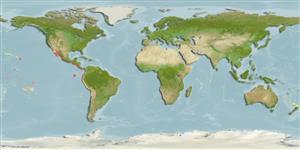Teleostei (teleosts) >
Beloniformes (Needle fishes) >
Exocoetidae (Flyingfishes)
Etymology: Fodiator: Derived from Latin, fodere = to dig, someone that digs (Ref. 45335).
More on author: Günther.
Environment: milieu / climate zone / depth range / distribution range
Ecology
Marine; pelagic-neritic; depth range 0 - ? m. Tropical; 36°N -
Eastern Pacific: Baja California, Mexico and the Gulf of California to Peru, including the Clipperton and Galapagos Islands. Records from the Indo-West Pacific are misidentifications, e.g. of Parexocoetus mento (Ref. 27313).
Size / Weight / Age
Maturity: Lm ? range ? - ? cm
Max length : 19.0 cm SL male/unsexed; (Ref. 9300)
Epipelagic and neritic, usually at surface in warm coastal waters (Ref. 33606). May leap out of the water and glide for considerable distances above the surface. Oviparous, with planktonic larvae (Ref. 36606). Eggs are attached to floating objects via long filaments (Ref. 36606).
Life cycle and mating behavior
Maturity | Reproduction | Spawning | Eggs | Fecundity | Larvae
Parin, N.V., 1995. Exocoetidae. Peces voladores. p. 1091-1103. In W. Fischer, F. Krupp, W. Schneider, C. Sommer, K.E. Carpenter and V. Niem (eds.) Guia FAO para Identification de Especies para lo Fines de la Pesca. Pacifico Centro-Oriental. 3 Vols. FAO, Rome. (Ref. 9300)
IUCN Red List Status (Ref. 130435)
Threat to humans
Harmless
Human uses
Fisheries: subsistence fisheries
More information
ReferencesAquacultureAquaculture profileStrainsGeneticsElectrophoresesHeritabilityDiseasesProcessingNutrientsMass conversion
Tools
Special reports
Download XML
Internet sources
Estimates based on models
Preferred temperature (Ref.
123201): 15.7 - 26.4, mean 20.3 °C (based on 66 cells).
Phylogenetic diversity index (Ref.
82804): PD
50 = 0.7500 [Uniqueness, from 0.5 = low to 2.0 = high].
Bayesian length-weight: a=0.00646 (0.00292 - 0.01429), b=3.04 (2.84 - 3.24), in cm total length, based on LWR estimates for this (Sub)family-body shape (Ref.
93245).
Trophic level (Ref.
69278): 3.4 ±0.4 se; based on size and trophs of closest relatives
Resilience (Ref.
120179): High, minimum population doubling time less than 15 months (Preliminary K or Fecundity.).
Fishing Vulnerability (Ref.
59153): Low vulnerability (13 of 100).
